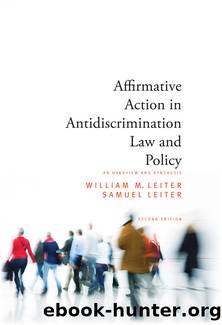Affirmative Action in Antidiscrimination Law and Policy by Leiter William M.;Leiter Samuel; & SAMUEL LEITER

Author:Leiter, William M.;Leiter, Samuel; & SAMUEL LEITER [Leiter]
Language: eng
Format: epub
ISBN: 3407307
Publisher: State University of New York Press
Published: 2011-03-03T00:00:00+00:00
Following Miller, in 1996, the Court ruled that a number of congressional districts were shaped predominantly by racial considerations and would not pass strict scrutiny. One of these was the redistricting plan involved in Shaw v. Reno (1993).139 In Shaw v. Hunt, (1996)140 the Court invalidated North Carolina's Twelfth Congressional District, once again maintaining as it had done in Miller v. Johnson (1996),141 that strict scrutiny was not satisfied despite the fact that the district was created to conform with the Section 5 preclearance requirements imposed by DOJ. That department was bluntly reminded by the Court that the national government was not authorized to require the states to maximize the number of majority-minority districts.
In Bush v. Vera (1996),142 three Texas majority-minority districts were also struck down in 1996 as unconstitutional under the Miller rule. Six separate opinions were filed, none joined by more than three justices. The principal opinion in support of the judgment was delivered by Justice O'Connor, writing for herself, Chief Justice Rehnquist, and Justice Kennedy. In restating the Miller 143 rule, Justice O'Connor said: [Strict scrutiny does not] âapply to all cases of intentional creation of majority-minority districts, ⦠[but only upon a showing] ⦠that other, legitimate districting principles were âsubordinatedâ to race.â144 Justice Thomas, joined by Scalia, did not accept O'Connor's nonacceptance of strict scrutiny with regard to some intentionally created majority-minority districts. In a caustic vein, he wrote that: âOnly last Term, in Adarand Constructors v. Peña, we vigorously asserted that all government racial classifications must be strictly scrutinized.â145
Shaw v. Reno and its progeny cases in the 1990s evoked a number of harsh dissents from Justices Stevens, Souter, Ginsberg, and Breyer. The dissenters expressed their commitment to enhancing minority voting power as a legal and moral imperative. In their view, the Shaw doctrine is constitutional heresy, impossible to apply, and should be repealed. A representative sample is the following excerpt from the Bush v. Vera dissent filed by Justice Souter, normally the Court's most dedicated guardian of stare decisis:
[The predominance test is inherently flawed because many] ⦠traditional districting principles cannot be applied without taking race into account and are thus, as a practical matter, inseparable from the supposedly illegitimate racial considerations.146
[In continuing to adhere to this doctrine, the Court fails] ⦠to provide a coherent concept of equal protection injury ⦠[or a coherent test for determining its existence.]147 [It is impossible to comply with Miller's] ⦠obligation to untangle racial considerations from so-called ârace-neutralâ objectives (such as according respect to community integrity and protecting the seats of incumbents) when the racial composition of a district and voter behavior bar any practical chance of separating them.148
[The Court's options for dealing with Shaw's unworkability are] ⦠to confine the cause of action by adopting a quantifiable shape test or to eliminate the cause of action entirelyâ¦. [T]here is presently no good reason that the Court's withdrawal from the presently untenable state of the law should not be complete.149
Download
This site does not store any files on its server. We only index and link to content provided by other sites. Please contact the content providers to delete copyright contents if any and email us, we'll remove relevant links or contents immediately.
| Civil Rights | Discrimination |
| General | Human Rights |
Day by Elie Wiesel(2252)
The Age of Genius by A. C. Grayling(2177)
Gideon's Spies: The Secret History of the Mossad by Gordon Thomas(1956)
The Gulag Archipelago (Vintage Classics) by Aleksandr Solzhenitsyn(1732)
FATWA: Hunted in America by Pamela Geller(1726)
Columbine by Dave Cullen(1505)
Examples & Explanations: Administrative Law by William F. Funk & Richard H. Seamon(1334)
Men Explain Things to Me by Rebecca Solnit(1324)
The Rule of Law by Bingham Tom(1323)
Anatomy of Injustice by Raymond Bonner(1273)
Three Cups of Tea by Greg Mortenson(1264)
ADHD on Trial by Michael Gordon(1247)
That Every Man Be Armed by Stephen P. Halbrook(1244)
Gideon's Spies by Gordon Thomas(1219)
Palestinian Walks by Raja Shehadeh(1145)
The Source by James A. Michener(1140)
Fast Times in Palestine by Pamela Olson(1123)
Nothing to Envy by Barbara Demick(1045)
Constitutional Theory by Carl Schmitt(1042)
